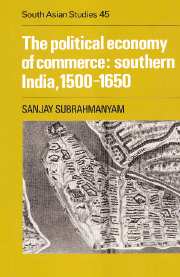Book contents
- Frontmatter
- Contents
- List of illustrations
- List of tables
- Preface
- Abbreviations used
- Introduction
- 1 The political economy of southern India, 1500–1650: preliminary remarks
- 2 Coastal trade and overland trade: complementarities and contradictions
- 3 Overseas trade, 1500–1570: traders, ports and networks
- 4 Overseas trade, 1570–1650: expansion and realignment
- 5 Europeans and Asians in an age of contained conflict
- 6 External commerce and political participation
- 7 Situating trade: models and methodological strategies
- Conclusion
- A note on currency and weights
- Glossary
- Note on sources
- Bibliography
- Index
- CAMBRIDGE SOUTH ASIAN STUDIES
4 - Overseas trade, 1570–1650: expansion and realignment
Published online by Cambridge University Press: 13 January 2010
- Frontmatter
- Contents
- List of illustrations
- List of tables
- Preface
- Abbreviations used
- Introduction
- 1 The political economy of southern India, 1500–1650: preliminary remarks
- 2 Coastal trade and overland trade: complementarities and contradictions
- 3 Overseas trade, 1500–1570: traders, ports and networks
- 4 Overseas trade, 1570–1650: expansion and realignment
- 5 Europeans and Asians in an age of contained conflict
- 6 External commerce and political participation
- 7 Situating trade: models and methodological strategies
- Conclusion
- A note on currency and weights
- Glossary
- Note on sources
- Bibliography
- Index
- CAMBRIDGE SOUTH ASIAN STUDIES
Summary
The last quarter of the sixteenth century marks the beginning of a substantial process, simultaneously of realignment and expansion, in the networks of overseas commerce involving the ports of southern India. In part, this is reflected in the rise of certain ports and the decline of others, for, as we have seen in the previous chapter, both Bhatkal and Pulicat – earlier the most substantial trading centres by far on the west and east coast respectively – now enter into decadence. These ports are not replaced by other neighbouring centres in a straightforward fashion; instead, one observes in the case of Pulicat a complex relationship with the rise of the north Coromandel port of Masulipatnam, and in the case of Bhatkal, a process of dispersion of trade to smaller centres along the west coast. The major centre of the late sixteenth and early seventeenth century in south-western India is Cochin, and we shall be at some pains in this chapter to trace the fortunes of this port. Our discussion must commence however with the eastern seaboard of south India, and in particular with a consideration of the fortunes of the two ports that dominate its trade in the decades from 1570 to 1650, namely Masulipatnam to the north, and Nagapattinam far to the south.
The Bay of Bengal, 1570–1600: introduction
It has already been suggested that the major reorientations which occurred in Coromandel's trade in the sixteenth century took place in the latter half, being linked to a set of changes we have associated with the ‘second wind’ of Portuguese impact.
- Type
- Chapter
- Information
- The Political Economy of Commerce: Southern India 1500–1650 , pp. 144 - 251Publisher: Cambridge University PressPrint publication year: 1990



